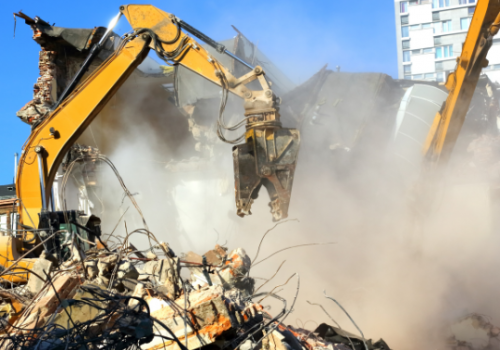In recent years, the demolition industry has undergone significant transformations driven by advancements in technology and increased environmental awareness. However, the environmental impact of modern demolition practices remains a critical concern. While contemporary techniques often aim to reduce waste and enhance recycling efforts, the sheer scale and nature of demolition projects continue to present challenges. This complex issue encompasses a range of factors, including the disposal of hazardous materials, the release of dust and pollutants, and the energy consumed by heavy machinery. Modern demolition practices have increasingly adopted strategies to mitigate these impacts, such as deconstruction and material reclamation, which focus on salvaging and repurposing building components. Yet, the effectiveness of these methods can vary depending on the project scale and execution. Understanding the environmental implications of modern demolition is essential for developing more sustainable practices and reducing the industry’s overall ecological footprint.
Demolition, the process of dismantling buildings or structures, has evolved significantly from its early days. Today’s modern demolition techniques focus not only on efficiency but also on minimizing environmental impact. Understanding these techniques is crucial for recognizing how they affect the environment and what improvements can be made. Let’s explore eight fundamental modern demolition techniques and their implications.
Mechanical demolition is one of the most common methods used today. This technique involves the use of heavy machinery such as excavators equipped with specialized attachments like shears, crushers, and pulverizers. These machines can quickly dismantle large structures, breaking them down into manageable pieces. While efficient, mechanical demolition can generate significant noise and dust, which are important factors to consider for environmental and public health.

Controlled demolition, also known as implosion, is a highly precise method used for large structures, such as high-rise buildings. This technique involves placing explosives at strategic points to collapse the structure in on itself. Controlled demolition is designed to minimize damage to surrounding areas and reduce debris spread. However, it requires careful planning and safety measures to mitigate environmental impacts such as dust and noise.
Deconstruction is a method that emphasizes the careful disassembly of buildings to salvage and recycle as many materials as possible. Unlike traditional demolition, deconstruction focuses on preserving valuable materials and components for reuse or recycling. This technique reduces landfill waste and supports sustainability by promoting the circular economy. It is more labor-intensive and time-consuming but can significantly lower the environmental footprint of demolition projects.
Selective demolition involves the targeted removal of specific parts of a structure, rather than complete demolition. This method allows for the preservation of certain elements of a building, such as historical features or reusable materials. By focusing on only the necessary parts, selective demolition helps reduce overall waste and environmental disruption. It is particularly useful in renovation projects where maintaining part of the existing structure is desirable.
Hydraulic excavation uses high-powered hydraulic equipment to dismantle structures. This technique is effective for breaking down concrete and other tough materials. The equipment is equipped with various attachments, such as breakers and shears, that allow for precise and controlled demolition. Hydraulic excavation can be more environmentally friendly compared to traditional methods as it generates less dust and noise, though it still requires careful handling of debris.
Traditional demolition methods, while effective for dismantling structures, have notable environmental impacts. Understanding these impacts is crucial for developing more sustainable demolition practices. In this section, we’ll explore eight key aspects of the environmental footprint associated with traditional demolition techniques.
Traditional demolition methods often result in significant amounts of waste. Entire structures are usually demolished and sent to landfills, with little consideration given to the recycling or repurposing of materials. This contributes to the depletion of natural resources and increases landfill usage, which has negative environmental consequences.
Demolition activities, especially those involving heavy machinery and explosives, generate large amounts of dust and emissions. This dust can contain hazardous particles, including asbestos and lead, which can be harmful to both human health and the environment. The release of these pollutants into the air can contribute to respiratory issues and environmental degradation.
The noise generated by traditional demolition methods is considerable. Heavy machinery, explosives, and mechanical equipment produce loud sounds that can disrupt local communities, wildlife, and ecosystems. Prolonged exposure to such noise pollution can have adverse effects on human health, including hearing loss and increased stress levels.
Traditional demolition methods often involve the use of energy-intensive machinery and equipment. This high energy consumption contributes to increased carbon emissions and environmental impact. The reliance on fossil fuels for operating machinery also adds to the overall carbon footprint of demolition activities.
The demolition process can cause significant disruption to surrounding ecosystems. The use of heavy machinery can lead to soil compaction and erosion, while the removal of vegetation can destroy local habitats. These disruptions can have cascading effects on local wildlife and plant species, leading to long-term environmental consequences.
Demolition projects generate a substantial amount of debris, which significantly impacts landfills and waste management systems. As structures are torn down, the resulting waste must be carefully managed to minimize environmental harm. Here are key points highlighting the impact of demolition debris:
The environmental impact of modern demolition is a pressing concern that requires mindful strategies and innovative solutions. By adopting sustainable practices, such as recycling materials, reducing waste, and using eco-friendly demolition techniques, we can mitigate the adverse effects on our planet. Companies like JUNKAHAULICS are at the forefront of this movement, ensuring that demolition projects are carried out with environmental responsibility in mind.
For more information on how we can assist with your next project while prioritizing sustainability, don’t hesitate to reach out to us. Contact JUNKAHAULICS at 4801 Glenwood Ave, Suite 200, Raleigh, NC 27612 or call us at (910) 403-3616. Our team is dedicated to providing effective and eco-conscious demolition solutions for your needs.


JUNKAHAULICS